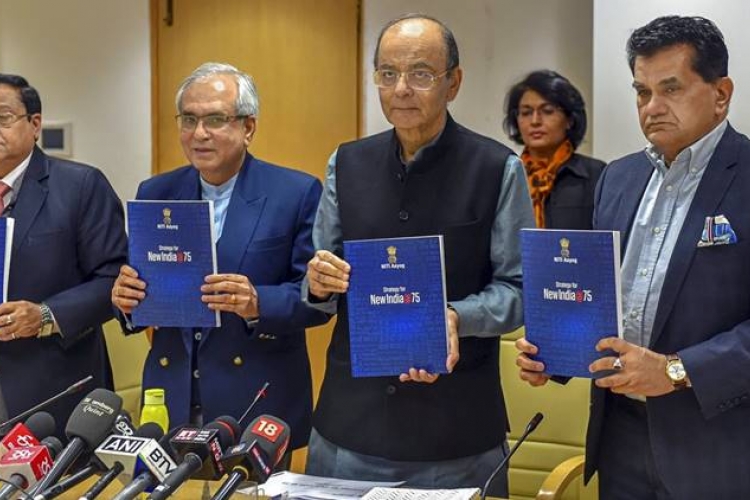STRATEGY FOR A NEW INDIA @ 75 - Vision document released by NITI Aayog
IN NEWS
A growth rate of 9% is essential to generate enough jobs and achieve universal prosperity, according to a vision document released by NITI Aayog. Towards this, the ‘Strategy for New India @75’ document recommends a number of steps, including increasing the investment rate, reforming agriculture, and codifying labour laws.
Aim of this mission
The document aims to more enhance the policy atmosphere in which private buyers and other stakeholders can add their fullest to acquiring the ambitions set out for New India 2022 and propel India in the direction of a USD 5 trillion economy by 2030. The documents have been merged under 4 sections – Motorists, Infrastructure, Inclusion and Governance.
Some of the key recommendations in the section on drivers include:
- Steadily accelerate the economy to achieve a GDP growth rate of about 8% on average during 2018-23.
- In agriculture, shift the emphasis to converting farmers to ‘agripreneurs’ by further expanding-National Agriculture Markets and replacing the Agricultural Produce Marketing Committee Act with the Agricultural Produce and Livestock Marketing Act.
- Give a strong push to ‘Zero Budget Natural Farming’ techniques that reduce costs, improve land quality and increase farmers’ incomes.
- To ensure maximum employment creation, complete codification of labor laws and a massive effort must be made to upscale and expand apprenticeships.
- Launch a mission “Explore in India” by revamping minerals exploration and licensing policy.
Some of the key recommendations in the section on infrastructure include:
- Rail Development Authority will advise or make informed decisions on an integrated, transparent and dynamic pricing mechanism for the railways.
- Double the share of freight transported by coastal shipping and inland waterways..
- Aim to deliver all government services at the state, district, and gram panchayat level digitally by2022-23.
Some of the key recommendations in the section on inclusion include:
- Successfully implementing the Ayushman Bharat programme including the establishment of 150,000 health and wellness centres across the country, and rolling out the Pradhan Mantri Jan Arogya Abhiyaan (PM-JAY).
- Create a focal point for public health at the central level with state counterparts. Promote integrative medicine curriculum.
- Upgrade the quality of the school education system and skills, including the creation of a new innovation ecosystem at the ground level by establishing at least 10,000 Atal Tinkering Labs by 2020.
- Conceptualize an electronic national educational registry for tracking each child’s learning outcomes.
- The final section on Governance delves deep into how the governance structures can be streamlined and processes optimized to achieve better developmental outcomes.
Some of the key recommendations in the section on governance include:
- Implement the recommendations of the Second Administrative Reforms Commission.
- Set up a new autonomous body, viz., the Arbitration Council of India to grade arbitral institutions and accredit arbitrators to make the arbitration process cost effective and speedy, and to preempt the need for court intervention.
- Address the backlog of pending cases - shift part of workload out of regular court system.
- Expand the scope of Swachh Bharat Mission to cover initiatives for landfills, plastic waste and municipal waste and generating wealth from waste.
ANALYSIS
- The strategy document talks of 8 per cent growth, with the caveat that employment has to be generated. This is a tough one because job growth has lagged income growth with all new methodologies but real employment continues to lag. Therefore, balancing growth and employment is going to be challenging.
- The strategy rightly says that we need to have a 36 per cent investment rate. If the banking sector is in a mess and one of the reasons for this is that the same system lent heavily for infrastructure and to industry when the capital formation rate was 36 per cent. And, expecting the rate to jump from 28.5 per cent to 36 per cent in the next 4 years should not be at the expense of the quality of the banking system.
- The tax analysis is good, and the NITI Ayog is speaking of increasing taxes. But this also looks difficult: The government has data to show that the number of assesses has increased after demonetisation and GST, but that does not reflect in tax collections yet. Creating jobs at the lower level in construction and retail is a good sign, but only when low salaries and wages would be out of the tax bracket.
- Increase of exports from $478 billion to $ 800 billion may be too ambitious, given that the every nation is trying to protect their industries and jobs. This being the case, pushing exports will be challenging.
It is always good to have such sign-posts but they have to be backed with action plans. Otherwise it leads to disappointment and such plans remain on the shelf .


 IAS -2025 Prelims Combined Mains Batch - III Starts - 14-04-2024
IAS -2025 Prelims Combined Mains Batch - III Starts - 14-04-2024